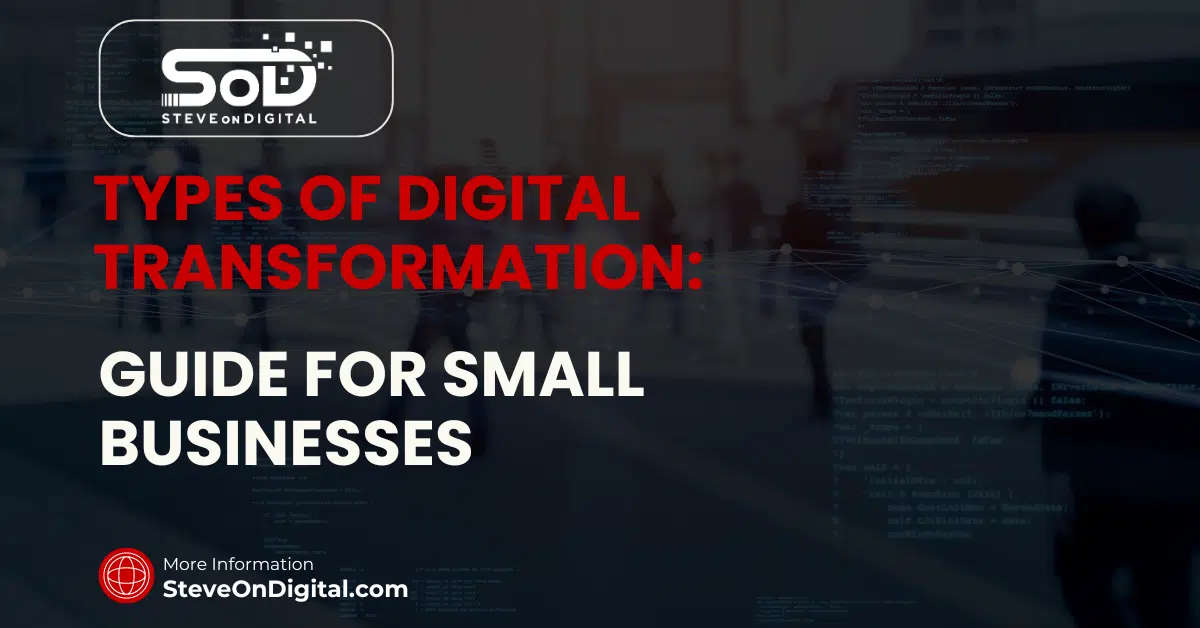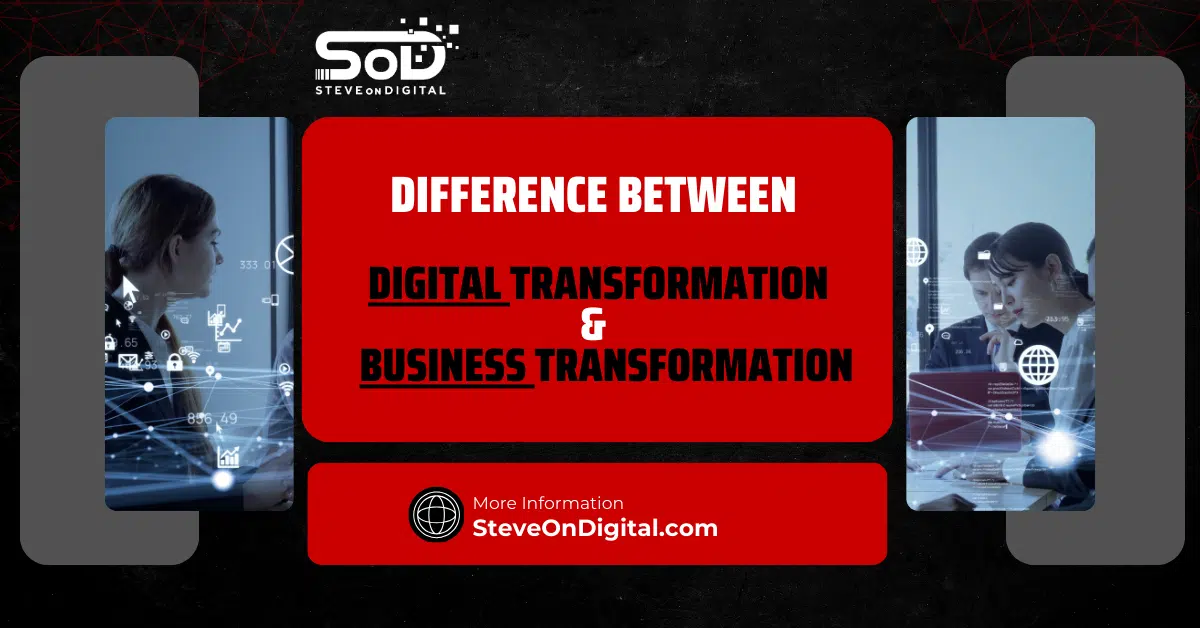Types of digital transformation refer to the different ways businesses can adapt to the digital age, including changes to business models, processes, domains, and organizational culture. Each type targets a specific area of a business, helping it thrive in a competitive market.
Understanding these types is crucial for small businesses to navigate digital challenges effectively. Digital transformation is not just about new technologies; it’s about rethinking how businesses operate and deliver value to customers. This process can lead to improved efficiency, better customer experiences, and increased revenue, ensuring long-term success in a digital world.
I’m Steve, a digital transformation expert with a strong background in electrical engineering, an MBA, and a master’s in Project Management. I excel at helping SMEs navigate the digital landscape with practical insights. Let’s begin!
Overview Of Digital Transformation
At its core, digital transformation is about leveraging technology to improve business outcomes. It’s not just about adopting new tools but rethinking how businesses operate. Digital transformation impacts everything from business models to customer experiences, fundamentally changing how companies interact with the world.
What Is Digital Transformation?
Digital transformation is the process of integrating digital technologies into all aspects of a business. This process often leads to profound changes in how a company operates and delivers value to its customers. It involves not only updating technology but also adapting business models, processes, and corporate culture to meet the demands of the digital age.
In my experience, digital transformation is most successful when it’s aligned with the business’s goals. For example, if a company aims to enhance customer satisfaction, digital tools like AI-driven customer support or data analytics can be pivotal.
Importance Of Digital Transformation
Staying competitive in today’s market requires more than just a good product or service. Digital transformation enables businesses to meet evolving customer expectations and adapt to changes in the market. It’s not just about surviving; it’s about thriving in a digital world.
For instance, adopting cloud computing infrastructure can help businesses scale operations quickly and cost-effectively. According to a recent study, businesses that undergo digital transformation are 2.5 times more likely to experience a significant increase in revenue growth. This statistic highlights the importance of embracing digital transformation initiatives to drive business success.
Types Of Digital Transformation
There are several types of digital transformation, each addressing different aspects of a business. Understanding these types can help you determine where to focus your efforts for the most significant impact.
Business Model Transformation
One of the most critical types of digital transformation is business model transformation. This involves changing the fundamental way a company delivers value to its customers. It’s not just about tweaking existing processes but about rethinking the entire business model.
Case Studies Of Business Model Transformation
Netflix is a prime example of successful business model transformation. Initially, they were a DVD rental service. However, by adopting a streaming model and leveraging digital technologies, Netflix transformed into a global entertainment giant. Their success underscores the power of digital transformation in reshaping business models to meet new market demands.
Business Process Transformation
Business process transformation focuses on reengineering internal processes to improve efficiency and effectiveness. This type of transformation is often driven by the need to reduce costs, increase speed, or improve the quality of outputs.
Key Processes In Business Transformation
Critical processes that are often targeted for transformation include supply chain management and customer service. For instance, implementing robotic process automation (RPA) in supply chain management can drastically reduce errors and increase efficiency. A recent report shows that companies using RPA have reduced operational costs by up to 30%.
Domain Transformation
Domain transformation occurs when a company expands into a new market or domain by adopting new technologies. This type of transformation can open up new revenue streams and opportunities for growth.
Examples Of Domain Transformation
Amazon is a notable example of domain transformation. Originally an online bookstore, Amazon expanded into cloud computing with Amazon Web Services (AWS), which now generates a significant portion of its revenue. This move demonstrates how domain transformation can lead to new business models and markets.
Cultural Transformation
Cultural transformation is often the most challenging type of digital transformation. It involves changing the mindset and behaviors within an organization to support new ways of working. Without the right culture, even the best digital transformation strategy can fail.
Importance Of Company Culture
A strong company culture is essential for driving successful digital transformation initiatives. When employees are open to change and innovation, the transition is much smoother. Companies like Google have long emphasized a culture of innovation, which has been a critical factor in their continued success in the tech industry.
Key Technologies Driving Digital Transformation
When it comes to digital transformation, technology is the driving force. Over the years, I’ve observed how certain technologies have reshaped entire industries, allowing businesses to operate more efficiently and connect with customers in new ways. Let’s dive into some of the key technologies that are pivotal to digital transformation.
Cloud Computing
Cloud computing is one of the most significant enablers of digital transformation. By allowing businesses to store and process data on remote servers, cloud computing infrastructure offers flexibility, scalability, and cost efficiency. In fact, 94% of enterprises already use a cloud service, which underscores its critical role in today’s digital landscape.
The benefits of cloud computing environments extend beyond just data storage. They provide a foundation for companies to build and deploy applications at a fraction of the cost and time compared to traditional IT infrastructure. For small businesses, this means access to resources and computing power that were once only available to large corporations.
Artificial Intelligence And Machine Learning
Artificial Intelligence (AI) and Machine Learning (ML) are game-changers in the digital transformation arena. These technologies enable businesses to automate processes, analyze large datasets, and make informed decisions quickly. In my experience, implementing AI-driven solutions can significantly enhance operational efficiency and customer satisfaction.
AI In Customer Experience
AI is transforming how businesses interact with their customers. For instance, chatbots powered by AI can provide 24/7 customer support, offering instant responses and solutions to common issues. This not only improves the customer experience but also reduces operational costs. According to recent studies, businesses that use AI in customer service report a 10-15% increase in customer satisfaction.
Data Analytics And Insights
Data is the new oil, and how you manage and analyze this data can make or break your digital transformation efforts. Data analytics provides the insights needed to make informed business decisions, predict trends, and understand customer behavior. It’s no longer just about collecting data but about turning that data into actionable insights.
Managing Data For Business Outcomes
Managing data effectively is crucial for achieving desired business outcomes. This involves not just storing data but ensuring it’s accessible and usable. I’ve seen companies struggle with this, only to realize that without a solid data management strategy, their digital transformation efforts fall flat. By leveraging technology like edge computing and data analytics, businesses can gain a competitive advantage, streamline operations, and drive revenue growth.
Digital Transformation Strategies
A successful digital transformation requires more than just adopting new technologies. It’s about having a clear strategy that aligns with your business goals. Here’s how you can develop a winning digital transformation strategy.
Assessing Current Digital Capabilities
Before diving into digital transformation, it’s essential to assess your current digital capabilities. This involves taking stock of the digital tools and technologies you already have in place and determining how they align with your business needs. I always recommend starting with a digital maturity assessment to identify gaps and opportunities.
Setting Clear Business Goals
Digital transformation should be driven by clear business goals. Whether you’re aiming to enhance customer experience, boost operational efficiency, or drive revenue growth, your goals will steer your transformation journey. Aligning these goals with your digital transformation initiatives is critical to ensuring that your efforts yield tangible results.
Implementing Digital Transformation Frameworks
Once you’ve assessed your capabilities and set your goals, the next step is implementing a digital transformation framework. These frameworks provide a structured approach to managing your digital transformation projects. They help ensure that all aspects of the transformation are aligned with your overall business strategy and that you stay on track to achieve your objectives.
Key Performance Indicators
Measuring the success of your digital transformation strategies is crucial. Key performance indicators (KPIs) help you track progress and identify areas for improvement. In my experience, setting specific, measurable KPIs can mean the difference between a successful transformation and one that falls short of expectations.
Challenges In Digital Transformation
While digital transformation offers immense benefits, it’s not without its challenges. Understanding these challenges can help you prepare and navigate your transformation journey more effectively.
External Challenges
External factors like competition and regulatory changes can significantly impact your digital transformation success. For example, industries with strict regulatory requirements may face additional hurdles when adopting new digital technologies. Keeping an eye on these external challenges and being adaptable is crucial for staying ahead.
Internal Challenges
Internal challenges, such as company culture and resource allocation, can also pose significant obstacles. In my experience, one of the most common internal challenges is resistance to change. Employees may be hesitant to adopt new processes or technologies, which can slow down your transformation efforts.
Overcoming Internal Resistance
Overcoming internal resistance requires strong leadership and clear communication. It’s important to involve your team in the transformation process from the start and ensure they understand the benefits of the changes being made. Providing training and support can also help ease the transition and encourage a culture of innovation within your organization.
Digital Transformation Examples
When it comes to digital transformation, seeing is believing. Over the years, I’ve observed numerous industries undergo profound changes thanks to the adoption of digital technologies. Here, I’ll share some real-world examples from various sectors that illustrate how businesses have successfully implemented digital transformation projects.
Examples From The Retail Industry
Retail has been one of the most dynamic sectors in embracing digital transformation. Companies have leveraged digital technologies to enhance customer experiences and streamline operations. A prime example is Walmart, which has implemented a range of digital transformation initiatives. They’ve integrated machine learning and data analytics to optimize supply chain management, ensuring products are stocked efficiently based on customer demand.
Another great example is Amazon, which has revolutionized the retail industry by using AI to predict customer preferences, thereby offering personalized shopping experiences. This not only improves customer satisfaction but also drives revenue growth. According to recent data, companies that adopt AI in retail can expect up to a 30% increase in efficiency and a 15% increase in customer satisfaction.
Examples From The Manufacturing Industry
Manufacturing is another sector that has seen significant improvements through digital transformation. One of the key technologies driving this change is robotic process automation (RPA). Companies like General Electric have adopted RPA to automate repetitive tasks, reducing errors and improving operational efficiency.
In addition, the adoption of cloud computing infrastructure in manufacturing has allowed companies to manage data and processes remotely, leading to more streamlined operations. For instance, Siemens has utilized digital twins—virtual replicas of physical assets—to enhance product design and reduce time-to-market by 50%.
Examples From The Financial Services Industry
The financial services industry has also been quick to adopt digital transformation, primarily to enhance service delivery and ensure compliance with regulatory requirements. For example, JPMorgan Chase has leveraged AI and machine learning to detect fraudulent activities in real-time, significantly reducing financial losses.
Another example is the use of cloud computing environments by financial institutions to improve data security and operational efficiency. The adoption of cloud technologies has enabled these institutions to offer seamless customer experiences, especially in online banking, where customer expectations are continually rising. Recent statistics show that 80% of financial institutions that have embraced cloud transformation report improved operational efficiency.
Best Practices For Digital Transformation
As with any significant change, successfully implementing digital transformation requires a well-thought-out strategy. Here are some best practices that I’ve found to be crucial in ensuring a smooth and successful digital transformation journey.
Engaging Stakeholders
One of the most important steps in digital transformation is engaging all stakeholders early in the process. This includes not just leadership but also employees, customers, and even suppliers. Everyone involved needs to understand the goals of the transformation and how it will impact them. I’ve seen projects falter simply because stakeholders weren’t adequately involved or informed.
Creating open lines of communication and offering training can help ease concerns and build support for the changes. For example, when implementing new digital tools, providing hands-on training sessions can help employees feel more comfortable and confident in using the new technologies.
Continuous Improvement
Digital transformation isn’t a one-time project; it’s an ongoing process. The technology landscape is constantly changing, and businesses need to adapt to stay competitive. This means continually evaluating and refining your digital transformation strategies.
In my experience, businesses that embrace a mindset of continuous improvement are more likely to succeed in their digital transformation efforts. Regularly reviewing key performance indicators (KPIs) and making adjustments as needed can help keep the transformation on track and ensure it continues to deliver value.
Final Thoughts
Digital transformation is not just a trend; it’s a necessity for businesses that want to thrive in today’s fast-paced environment. From retail to manufacturing to financial services, companies across all industries are reaping the benefits of embracing digital technologies. However, the journey is not without its challenges. By engaging stakeholders, continuously improving your strategies, and learning from real-world examples, you can navigate this journey successfully.
Remember, digital transformation is about more than just adopting new technologies. It’s about rethinking how your business operates and delivers value to customers. By keeping this focus, you’ll be well on your way to achieving digital transformation success.




